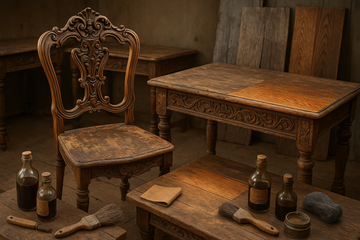How To Give Your Granite Countertop The Care It Deserves
So you’ve taken the plunge and invested in a stunning granite countertop for your kitchen. Of course, it’s well worth the money. After all, you’ve been told it’s stain resistant, water resistant, scratch resistant and heat resistant. In fact, it’s one of the hardest, most durable rocks on the earth. So surely it demands no maintenance. Unfortunately that’s not strictly true. Even the toughest things need care, especially when they’re subjected to regular abuse from cooking oil, red wine and burger grease. Cleaning stains on granite is particularly tricky and shows the specialist attention that this surface demands. But to find out how best to approach seasonal care and daily cleaning so as to maintain that ‘brand new’ look, read on
Seasonal sealing
- Checking porosity - Granite is naturally porous, so it is essential you apply a seal to protect it against absorbing liquids. To check the porosity of your countertop, splash a little water on the area that’s most heavily used. If it rests on the surface as small beads then your sealant is still effective, but if beads don’t appear and the surface darkens then it’s time to re-seal. Sealing your granite countertop is a process that needs to be carried about approximately every 3-12 months.
- How to seal - Simply wipe the surface and apply a sealant following the manufacturer’s instructions.
Day-to-day care
- Basic cleaning - Wipe your granite with soap and water - it’s that easy! Alternatively, use a gentle non-abrasive cleaner, such as Howard Natural Granite & Marble Cleaner. Always use a soft cloth and wipe dry with a chamois leather to remove streaks and maintain the shine. Remember to mop up spills immediately. Foods such as lemon juice, beetroot juice, vinegar and cooking oils pose a particular threat as they can seep through the surface and stain.
- Using hot pans - Whilst granite can easily withstand the heat of pans straight from the hob, there is a risk of hairline cracks due to intense differences in temperature i.e. cold granite and hot pan. What’s more, granite will absorb the heat from the pan and become very hot to touch. It’s recommended to use a hot pad or trivet for your pans.
- Chopping food - Since granite is so tough, it is in theory possible to chop food directly on your countertop rather than using a cutting board. However, whilst you are unlikely to damage your countertop, it is likely you could damage your knives and dull their blades. And there is a slight risk of staining the countertop caused by juices seeping from the chopped food. Therefore, it’s advisable to always use a cutting board.
Follow these simple steps to ensure your granite countertop stays at its very best. After all, if you’ve made the financial investment, then it’s certainly worth investing a little time and energy too in order to preserve this luxurious stone.





